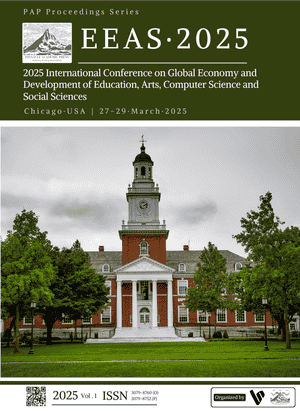Personal Extreme Violent Crimes: Typologies, Offender Profiles, and Innovative Prevention Frameworks for Public Security Agencies
Keywords:
personal extreme violent crimes, crime prevention, big data surveillance, law enforcement strategies, psychological analysisAbstract
Personal extreme violent crimes (PEVCs) pose severe threats to public security, exhibiting unique characteristics such as impulsive, antisocial behaviors, and the use of brutal methods that result in significant casualties and social impact. This study systematically analyzes PEVCs by exploring their classification, offender motivations, psychological structures, and behavioral patterns. The challenges in preventing and controlling these crimes are examined, particularly the unpredictability of offenders, the hidden nature of their intent, and institutional limitations in early intervention. Leveraging a big data framework, this paper proposes a comprehensive crime prevention strategy that integrates early warning systems, intelligence-driven surveillance, and enhanced emergency response mechanisms. Additionally, post-incident management measures, including community engagement initiatives and targeted social support programs, are discussed to mitigate the risks of PEVC recurrence. Finally, insights from community-based conflict resolution models are considered to address the root causes of these crimes. The study highlights the necessity of a multifaceted approach that combines law enforcement, social governance, and technological advancements to effectively prevent and control PEVCs.
References
1. A. Gopal, A. B. I. L. A. S. H., and H. A. R. O. L. D. J. Bursztajn, “Offender profiling: An introduction to the sociopsychological analysis of violent crime,” Am. J. Psychiatry, vol. 163, no. 3, p. 559-a, 2006, doi: 10.1176/appi.ajp.163.3.559-a.
2. T. T. Khoei and A. Singh, “A survey of emotional artificial intelligence and crimes: detection, prediction, challenges and future direction,” J. Comput. Soc. Sci., vol. 7, no. 3, pp. 2359–2402, 2024, doi: 10.1007/s42001-024-00313-3.
3. D. V. Canter and D. Youngs, Investigative Psychology: Offender Profiling and the Analysis of Criminal Action, Chichester, U.K.: John Wiley & Sons, 2009. ISBN: 9780470023976.
4. M. Kaur and M. Saini, “Role of artificial intelligence in crime prediction and pattern analysis studies published over the last decade: a scientometric analysis,” Artif. Intell. Rev., vol. 57, no. 8, p. 202, 2024, doi: 10.1007/s10462-024-10823-1.
5. X. Jiahui, “Efforts to prevent crime triggers in sexual murder cases in China through public education, victim protection, per-petrator rehabilitation, and law enforcement,” AL-MANHAJ: Jurnal Hukum dan Pranata Sosial Islam, vol. 6, no. 1, pp. 207–220, 2024, doi: 10.37680/almanhaj.v6i1.5053.
6. A. Greene‐Colozzi and J. D. Freilich, “Situational crime prevention as a harm mitigation policy for active shooter incidents,” Criminol. Public Policy, vol. 23, no. 4, pp. 947–979, 2024, doi: 10.1111/1745-9133.12686.
7. B. Lantz and J. Kim, “Hate crimes hurt more, but so do co-offenders: Separating the influence of co-offending and bias on hate-motivated physical injury,” Crim. Justice Behav., vol. 46, no. 3, pp. 437–456, 2019, doi: 10.1177/0093854818810314.
8. J. Van Dijk, P. Nieuwbeerta, and J. Joudo Larsen, “Global crime patterns: An analysis of survey data from 166 countries around the world, 2006–2019,” J. Quant. Criminol., pp. 1–36, 2021, doi: 10.1007/s10940-021-09501-0.
9. L. A. Torsu, “Crime prevention in the digital age: Challenges and technologies for policing in Aflao border township in Ghana,” The Police J., vol. 0032258X241309190, 2024, doi: 10.1177/0032258X241309190.
10. J. Ebner, C. Kavanagh, and H. Whitehouse, “Measuring socio-psychological drivers of extreme violence in online terrorist manifestos: An alternative linguistic risk assessment model,” J. Policing, Intell. Counter Terrorism, vol. 19, no. 2, pp. 125–143, 2024, doi: 10.1080/18335330.2023.2246982.
11. W.-Q. Chen, “Psychological analysis of severe violent crimes by minors,” Cambridge Open Engage, 2024, doi: 10.33774/coe-2024-7ftfp.
12. T. M. Encalada, “Psychopathic trait stability in males and female youth,” SSRN, 2024, doi: 10.2139/ssrn.4498611.
13. A. M. Slaughter, S. Hein, J. H. Hong, S. S. Mire, and E. L. Grigorenko, “Criminal behavior and school discipline in juvenile justice-involved youth with autism,” J. Autism Dev. Disord., vol. 49, pp. 2268–2280, 2019, doi: 10.1007/s10803-019-03883-8.
14. D. A. Díaz-Faes and N. Pereda, “Is there such a thing as a hate crime paradigm? An integrative review of bias-motivated violent victimization and offending, its effects and underlying mechanisms,” Trauma Violence Abuse, vol. 23, no. 3, pp. 938–952, 2022, doi: 10.1177/1524838020979694.
15. G. Roussos and J. F. Dovidio, “Homonegativity, perceived free speech protections, and perceptions of harm predict judgments of hateful acts motivated by sexual prejudice,” Psychol. Sex. Orientat. Gend. Divers., vol. 5, no. 4, p. 457, 2018, doi: 10.1037/sgd0000295.
16. M. H. Stone, “Violent crimes and their relationship to personality disorders,” Personality Ment. Health, vol. 1, no. 2, pp. 138–153, 2007, doi: 10.1002/pmh.18.
17. K. Mukherjee, S. Saha, S. Karmakar, and P. Dash, “Uncovering spatial patterns of crime: A case study of Kolkata,” Crime Prev. Community Saf., vol. 26, no. 1, pp. 47–90, 2024, doi: 10.1057/s41300-024-00198-4.
18. M. Quintana-Navarrete, “Extreme violence and weight-related outcomes in Mexican adults,” J. Health Soc. Behav., vol. 64, no. 3, pp. 401–416, 2023, doi: 10.1177/00221465231163906.
19. E. Mesok, “Beyond instrumentalisation: gender and agency in the prevention of extreme violence in Kenya,” in Gender and the Governance of Terrorism and Violent Extremism, New York, NY, USA: Routledge, 2023, pp. 88–109. ISBN: 9781003381266.
20. T. Menger, “Press the thumb onto the eye: Moral effect, extreme violence, and the transimperial notions of British, German, and Dutch colonial warfare, ca. 1890–1914,” Itinerario, vol. 46, no. 1, pp. 84–108, 2022, doi: 10.1017/S0165115321000371.
Downloads
Published
Issue
Section
License
Copyright (c) 2025 Ziyue Guo (Author)

This work is licensed under a Creative Commons Attribution 4.0 International License.



